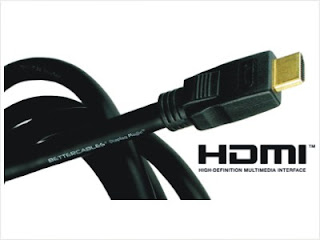Article first published as HDMI CONnection Scam Hits Consumers Hard on Technorati.
When it comes to HDMI cables, retailers and salesmen have had a roarin' good ol time at the expense of the consumer. It's time to put the facts where they are and show them up for what the are, CON MEN.I call it, the CONnection Scam.
Scenario: Joe Consumer is excited, he got his paycheck and finally has enough to get himself that flatscreen TV he's had his eye on for months now. The salesman starts telling him he needs special HDMI cable to connect his Blu-Ray, PS3, etc (this is true), now here comes the CONnection SCAM.
The salesman tries to sell Joe Consumer a 4 foot long $200 HDMI cable, confident that Joe Consumer has no idea that a $20 HDMI cable will do the exact same thing.
That's right, let me restate a fact in big bold red print to make sure this is clear:
A 4 foot long HDMI v1.4 cable costing $20 will perform the same as a HDMI v1.4 cable costing $200.
Let's see why: An HDMI or DVI video signal is a small signal and it is digital. It is either good or not good. As long as the length is under 8 feet, there is NO signal degredation.
Another CONnection Scam
You will see HDMI packages in the store, screaming "120 Hz," "240Hz" and "480 Hz".
HDMI cables can no more be manufactured for specific refresh-rate HDTVs than a garden hose can be manufactured specifically to water seeded lawns and sod lawns. The same water flows through either one.
The same HDTV signal flows through all HDMI cables, whether labeled "120Hz" or "480Hz" — or not labeled at all.
FACT: A TV's refresh rate has nothing whatsoever to do with the signal flowing to that set. The refresh rate is determined by the set's circuitry once the signal gets there, so how can different HDMI cables be manufactured for different refresh-rate sets?
HDMI Licensing LLC licenses the design, specifications and requires labeling of cables as either "Standard" or "High Speed." Only two types of HDMI cables are included in the HDMI licensing spec: "Standard" (aka category 1) or "High Speed" (aka category 2). Category 2 is required to insure the cable passes 1080P HD signals, (which includes 3-D), and is the highest bandwidth video signal available now and the forseable future. (The most current spec is Category 2, Version 1.4).
HDMI cable makers are intentionally misleading consumers by hyping their cables with the various refresh rates used by set makers to improve picture quality. Despite the fact that some labels indicate signals of 480Hz, the signal fed by an HDMI cable to a set never exceeds 60Hz.
Any "High Speed" HDMI v1.3 cable should handle any display and any video signal you can throw at it. Period. Full Stop. The next version is 1.4 which is intended for "4K" video, which only exists in extreme high end commercial applications.
As an extreme example of the CONnection scam, AudioQuest has a line of "High Speed" HDMI cables; its packaging states that it "delivers 100 percent of the data required for 120Hz, 240Hz, 600Hz displays." It costs up to a whopping $299.99 for its 9-8-foot Carbon model (sold online from Bestbuy.com).
What this means to you is that there really is no such thing as a "better" HDMI cable. Either an HDMI cable works or it does not. If it doesn't work, you will immediately know it. Your screen will freeze, or it will skip frames, or it will show big square blocks instead of a picture. It will be completely obvious that there is a problem. In that case you need to throw the cable away.
How much have YOU thrown out on HDMI cables? I would love to hear your comments! Link this article to your friends and see what they say!

No comments:
Post a Comment